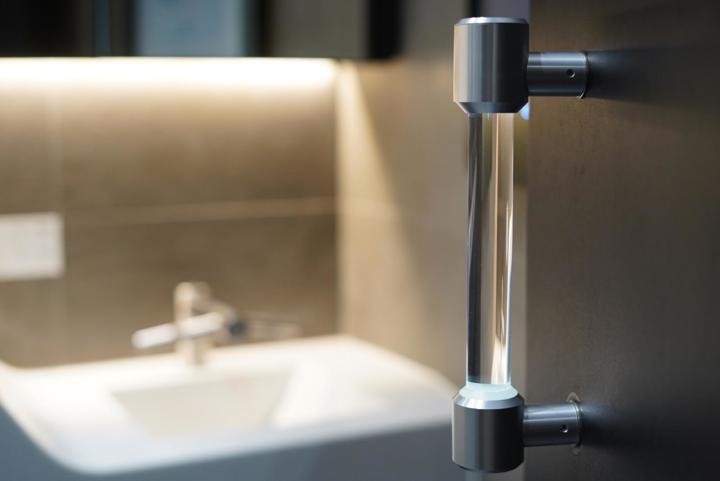Since 2004, James Dyson Award has provided young engineers and local students with an opportunity for international competition, themed “design something that solves a problem”, inspiring and encouraging students to tap their potential, designing inventions that could improve everyday life.
In 2003, HK suffered an outbreak of the global contagion respiratory disease SARS, resulting in 1,755 infections and 299 deaths, drawing the attention of Hong Kong and the world to public health. Simon Wong, a student majoring in Physic at the Chinese University of Hong Kong and Michael Li, a student in electrical engineering at the Royal Melbourne Institute of Technology in Australia, then still a primary school student, were young but farsighted, and they observed that one of the main reasons for the spread of the virus stemmed from contact. To solve this problem, they designed a door handle that can be automatically sterilized – Self Sanitizing Door Handle. The self-cleaning door handle utilises the power and photocatalysis generated by the action of opening and closing the door. When ultraviolet light is shone onto the Titanium Dioxide coating on the door handle, the surface bacteria are decomposed and the handle is thereby automatically disinfected. This innovative design concept, combined with a sleek and minimalist appearance, makes the self-cleaning door handle stand out among the many inventions, taking the national winner in James Dyson Award 2019.
In order to encourage students to developing their products continuously, national winners will be awarded HK$20,000 to continue the design and research path. Since the concept design was unveiled, the self-cleaning door handle has been acclaimed by all walks of life. In addition to winning the Gold Award, the 44th International Exhibition of Inventions of Geneva in 2016, it is now being used in commercial malls in Hong Kong and undergoing trial scheme in various schools and other shopping malls. Simon hopes that in the future the concept will be encapsulated in different public facilities, such as light-touch screens, to contribute to public health problems. Simon pointed out that the recognition of the judges will definitely be a powerful booster for the R&D path. The incentives from the award provides incredible support for R&D, allowing them to conduct more tests, apply for certification, and carry the concept forward. He pointed out, “Most public environments are cleaned using chemical cleaners, which are not long-lasting and harmful to humans. The self-cleaning door handle provides durable and efficient cleaning and disinfection of the contact surface, and is expected to be incorporated in more daily products and public facilities in the future.”
The award committee members appreciated the design concept of the self-cleaning door handle, and thought that the product was highly customizable. Frédéric Gooris, a Belgian industrial designer living in Hong Kong, said: "Public health has always been a topic of public concern. The designer applied the automatic disinfection concept to door handles; if the concept could be applied to more products and situations, such as escalators, touch screens, etc., it could make a significant contribution to public health. Therefore, the design concept of automatic disinfection is very suitable for the theme of the James Dyson Award - "design something that solves a problem", absolutely well-deserved. “
The encouragement and recognition of the award committee promotes the confidence of designers. The self-cleaning door handle shall represent Hong Kong alongside other exceptional Hong Kong products in the James Dyson Award international competition.
Two Runner-Ups:
Designed by Xin Tang, a postdoctoral student in the Department of Mechanical Engineering at the University of Hong Kong
Problem: In the medical and pharmaceutical industries, practitioners mostly use disposable liquid transfer products such as micropipette tips or microtubes during experiments to ensure experimental accuracy and avoid cross-contamination. Disposable laboratory supplies are easily contaminated by liquids and chemicals, making it difficult to classify and decompose waste, threatening environmental safety, and indirectly increasing the cost of diagnosis and treatment.
Solution: Loss-Free Fluids Gripper is a type of liquid handling tool consisting of hydrophilic fibres and superhydrophobic mesh. It extracts and processes traces of liquid without generating significant pollution, reduces loss due to disposable items in medical treatments and experiments, protecting the environment.
Designed by Padmanabhan Krishnamurthy, third-year undergraduate in Computer Science and Engineering at the Hong Kong University of Science and Technology, and Amrutavarsh Kinagi, third-year student in Computer Science and Mathematics at the Hong Kong University of Science and Technology
Problem: Hearing-impaired people find it difficult to communicate with people because of their impairment. They mostly use hearing aids or sign language as the main communication tool. Generally, hearing aids cannot separate voices from the noise of crowds. Costly AI hearing aids are out of reach for most hearing-impaired people. Sign language is not widely used in society. It is still a big problem for hearing-impaired people to communicate with the public, so daily social interaction is inconvenient.
Solution: HELEN is an automatic lip-reading wearable camera that uses the Lip Net Lip Reading AI system to analyse and record the video of the other party's speech, transcribes it into audio or Braille, and provides stable audio in noisy environments, reducing the communication barriers for the hearing-impaired, improving social interaction.



Share this page on